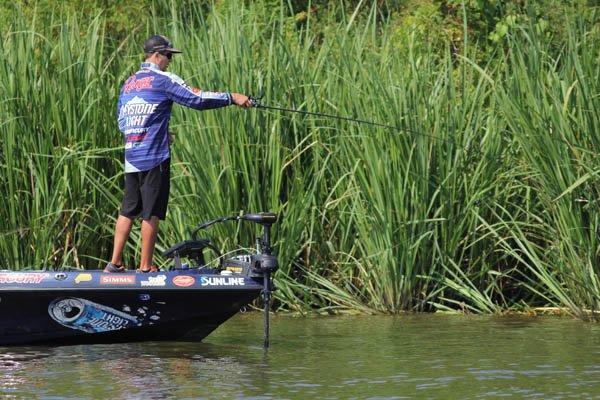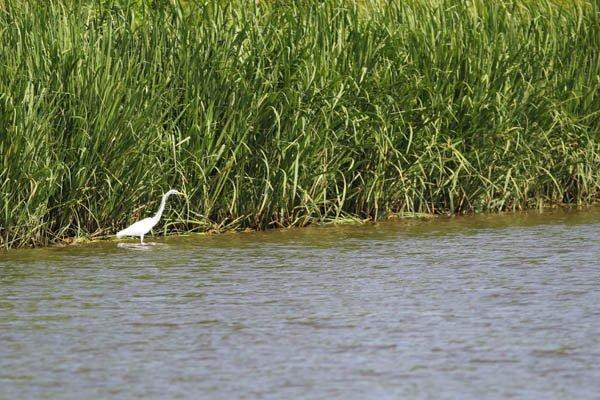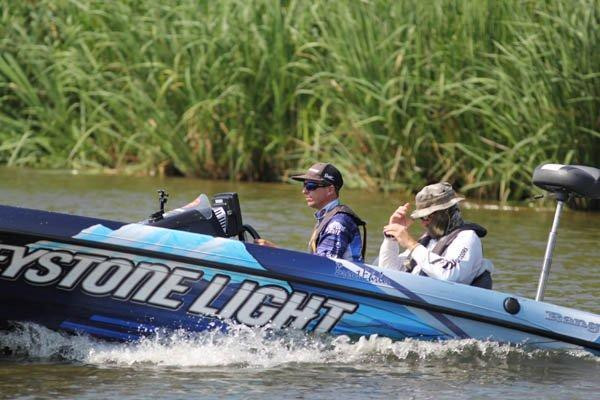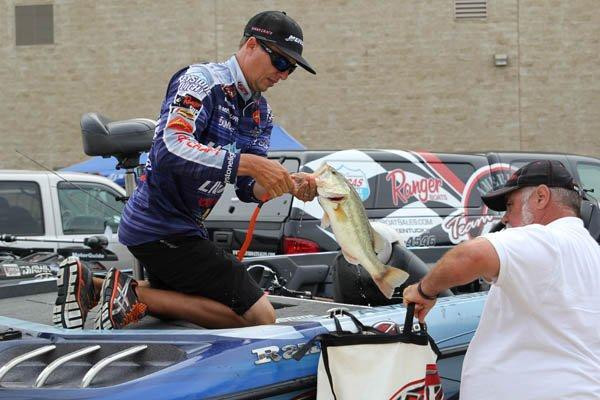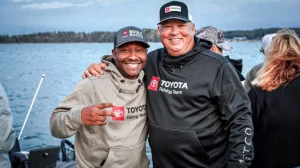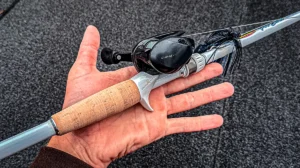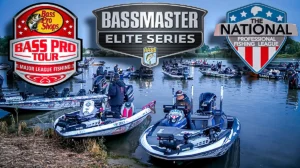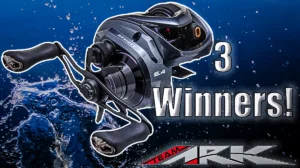High skies and hot temperatures aren’t always the most enjoyable conditions for bass fishing. As summer continues hanging around and before the bass make their annual trek to the creeks in search of shad and full bellies, a day on the water can turn into a fairly lackluster experience. If you’re looking for an easy way to bring life back into your fishing trips, consider fishing grass for late summer bass.
FLW Tour pro Brent Ehrler has an affinity for vegetation and often turns to grass when targeting stubborn, warm weather bass. According to him, if you know what to look for and how to approach it, you can turn average days into extraordinary days in a hurry.
Concentrate on the main lake or river
As with any bass fishing technique, it’s important to concentrate on areas of your favorite fishery that are most likely to hold large concentrations of bass. Understanding the importance of current is necessary when searching for the most productive grass.
“Current is a huge deal anytime you’re fishing in the summer,” Ehrler said. “It produces more oxygen in the water, which naturally attracts smaller forage such as bream and baitfish. Main lake and main river areas are going to give you more water flow opportunities. Even if you’re fishing in a reservoir void of moving water, all it takes is a little breeze to generate some game changing current.”
The seasonal behavior of bass also suggests staying near main lake areas. Until fall arrives, you can expect the large majority of bass to congregate near deep water areas.
“It’s very important to concentrate on the main lake during the summer,” Ehrler said. “When the oxygen quality in their deep, summertime homes depletes, they’re going to search for the nearest shallow cover. If the deep oxygen quality is still good, they’ll still come up to feed periodically in shallow water and then slide back to their deeper areas. If you can find grass near deep water, you’ll be in great shape.”
Recognize healthy water
As your search for productive grass continues, it’s important to train yourself to distinguish healthy water. If you’ve ever received a nasty salad at a restaurant, you’ll have an immediate leg up.
“Think of grass fishing in the summer as ordering a salad at a restaurant,” Ehrler said. “When the waiter brings you the salad, you know right away whether or not it’s going to taste good. If it’s brown, wilted and it looks like it’s been sitting in the kitchen for 3 days, it’s not healthy. The same goes for fishing grass.”
Ehrler spent a lot of time on this brightly colored stretch of bank at the Red River.
Finding key grass beds is a very visual technique for Ehrler. As he scans the banks for potential honey holes, he makes a concerted effort to find bright-green grass, which is indicative of rich oxygen content and ample forage. Brown grass is usually a dead giveaway of subpar bass habitat or an undesirable bottom composition.
“When grass dies, it messes with the water’s oxygen content which also discourages bass and bait from living there,” Ehrler said. “Brown grass can also be indicative of a soft bottom composition and I’m a huge believer that bass always favor a hard bottom. If you’re fishing an area and notice a bunch of brown, stringy grass wrapping around your bait, you’re probably better off fishing elsewhere.”
Because it’s difficult to scan shallow, shoreline grass with electronics, Ehrler uses a very simple technique to determine an area’s bottom composition. If he’s not getting bit in otherwise attractive areas, he lets his rod tip tell the story.
“If something doesn’t feel ‘right’ or if I’m not catching them in a great looking area, I simply stick my rod tip in the water and poke the bottom,” Ehrler said. “When I do that, I’m looking for a crunchy or sandy feeling and I’m trying to avoid mushy, nasty bottoms.”
Move quickly to develop a strong pattern
Ehrler doesn’t waste much time with unproductive grass. Instead, he moves quickly to increase his efficiency.
When flipping and pitching grass in the late summer, Ehrler looks for reaction bites. Instead of soaking his bait in one spot for an extended period of time, he moves quickly and efficiently to get dialed in on the bass’ preference.
“At the most, I’ll flip my bait in there and hop it 3 quick times and immediately make another flip,” Ehrler said. “I usually find that my initial drop is the most productive part of my cast. If they don’t eat it after a couple of hops, I’m making my next flip.”
If he starts getting bites in a specific area, Ehrler keeps his rapid pace, but he will concentrate his casts in a very deliberate manner. Instead of flipping his bait 3 feet apart, he’ll begin making flips only 1 foot from one another.
“Grass fishing this time of year is generally pretty easy to pattern,” Ehrler said. “They’re going to give themselves away quickly, so if I find an area loaded with fish, I just make more casts to one specific spot. I’m still only popping it a few times, but I want to keep my bait in the most productive strike zones.”
Key characteristics to look for
As Ehrler makes his way down a main lake or main river grass bed, he searches for any type of irregularity he can find. When he keys in on a specific type of irregularity, he knows he’s on to something strong.
Recognizing small irregularities in main river grass helped Ehrler catch several nice bass at the 2013 Forrest Wood Cup.
“I try to stay away from straight lines in grass beds,” Ehrler said. “Bass are ambush predators and they want to hide from their prey. I really like to find small points in grass beds. Now, it may only stick out a foot or two from the rest of the bed, but that’s a big deal to a bass. The same goes for small grass pockets—always look for something other than straight lines.”
The bass’ positioning in a grass bed can be very specific, also making it easy to target the most high-percentage areas. If you start to notice the bass congregating in pockets as opposed to points or vice versa, it’s a safe bet that other bass will be doing the same thing.
“If you’re fishing every nook and cranny, sometimes you’ll limit yourself,” Ehrler said. “When you get clued in, not only will you cover water quicker, but you’ll also be making a lot of high-percentage flips and pitches.”
Gear considerations
Ehrler doesn’t get too fancy when it comes to flipping and pitching grass for late summer bass. His setup has allowed him to catch big bass all around the country.
- Soft plastic – Yamamoto Flappin’ Hog: “It’s very basic for me,” Ehrler said. “I almost always start and finish a grass fishing day with a Flappin’ Hog. It spirals and planes on the fall, which results in a ton of grass bites when compared to other baits. Its unique action also generates a lot of bites when I’m retrieving it to make another cast, too. You absolutely cannot go wrong with this bait.”
- Rod – 7-foot, 6-inch heavy-action Lucky Craft Casting Rod
- Reel – Abu Garcia REVO Premier Generation 3 Casting Reel
- Line – 22-pound Sunline Shooter Fluorocarbon: “Shooter Fluoro is the strongest I have ever used,” Ehrler said. “Not only that, but it has very low memory which allows me to feel my bait better and fish with a single spool for a several consecutive days.”
- Weight – 3/8 or 1-ounce tungsten: “I want to use a weight that’s heavy enough to let my bait fall freely through the vegetation, but not too heavy so it falls like a bullet,” Ehrler said. “Generally, I like to use a 3/8-ounce weight in sparse grass beds and a 1-ounce tungsten in very thick grass.”
The next time you go fishing on your favorite lake, try to spend some time looking for productive grass beds. If you stay close to deep water, recognize productive grass and target irregularities, you’ll be very pleased with the results.


